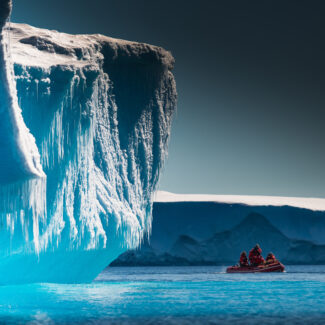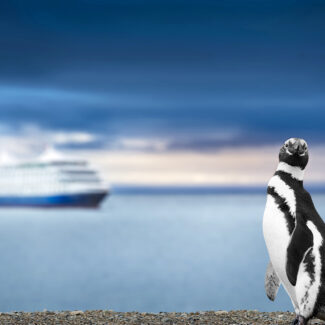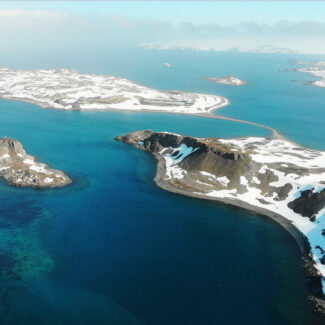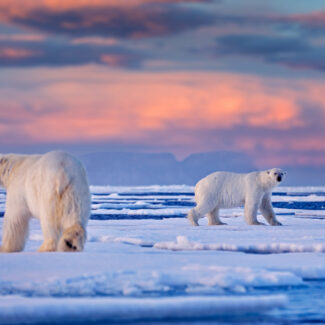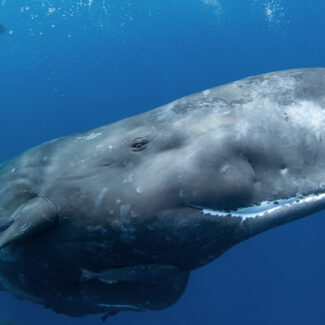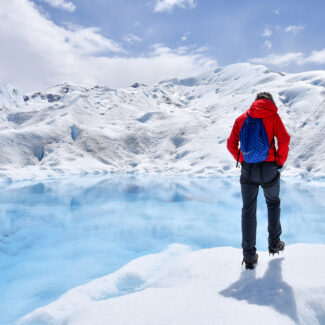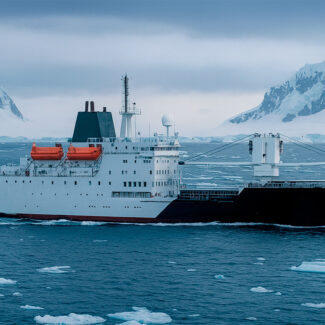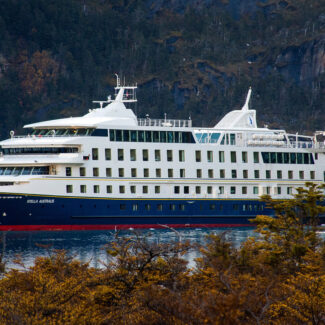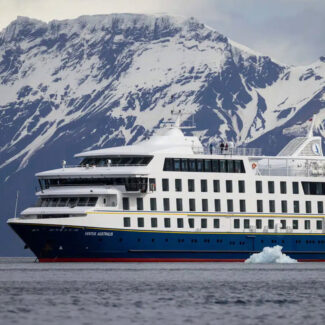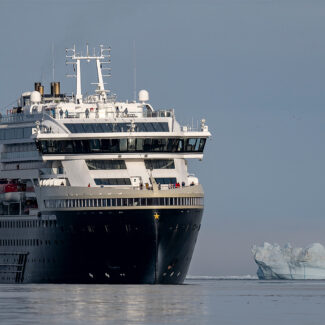10 Most Famous Arctic & Antarctic Expeditions of All Time
- The 5 Most Famous Arctic Expeditions
- (1) The Voyage of the Gjøa Through the Northwest Passage (1903-1906)
- (2) Frederick A. Cook’s North Pole Expedition (1908-1909)
- (3) Robert E. Peary’s North Pole Expedition (1908-1909)
- (4) The Flight of the Norge (1926)
- (5) The British Trans-Arctic Expedition (1968-1969)
- The 5 Most Famous Antarctic Expeditions
- (1) The 1839-1843 Ross Expedition
- (2) The Fram Expedition (1910-1912)
- (3) The Imperial Trans-Antarctic Expedition (1914-1917)
- (4) Operation Highjump (1946-1947)
- (5) Ranulph Fiennes & Mike Stroud’s Trans-Antarctic Crossing (1992-1993)
- Embark on Your Own Famous Polar Expedition
The Arctic and the Antarctic represented some of the final frontiers of human exploration, and indeed continue to draw both scientific interest and fresh ideas for novel adventures and feats of endurance.
In this article, we’ve compiled our picks for the five most famous expeditions in each of the polar realms—restricting our choices to those that either succeeded in their goals or came through with no loss of life. (After all, some of the most legendary polar journeys were those that turned into tragic ordeals, and we’ve got a dedicated writeup on those doomed trips.)
Imagine the awe that early polar explorers must have felt facing landscapes like this! These colossal icebergs hint at the formidable yet breathtaking environments that have drawn adventurers to the ends of the Earth for centuries. Prepare to discover the incredible stories of courage and resilience that unfolded in these icy realms.
The 5 Most Famous Arctic Expeditions
The following Arctic expeditions are certainly among the best-known of all time, even if such a short list necessarily leaves off some other remarkable undertakings: from Captain James Cook’s Arctic wayfaring in 1778 to Naomi Uemura’s 1976 dogsled sojourn from Greenland to Alaska.
(1) The Voyage of the Gjøa Through the Northwest Passage (1903-1906)
In late August 1906, Roald Amundsen and a crew of six others arrived in Nome, Alaska in their 47-tonne sloop Gjøa, in doing so becoming the first to sail through the long-strived-for Northwest Passage: the sea lane through the Canadian Arctic Archipelago connecting the North Atlantic and North Pacific.
The voyage had departed Oslo in June 1903, and in addition to successfully transiting the Northwest Passage—the quest for which had motivated explorers for centuries—it achieved another important goal during an extended stay at the King William Island anchorage that became known as Gjøa Haven: confirming that the North Magnetic Pole, first measured by James Clark Ross in 1831, was mobile, not a stationary point.
The other members of the Gjøa Expedition were Godfred Hansen, Anton Lund, Peter Ristredt, Helmer Hansen, Gustav Juel Wiik, and Adolf Henrik Lindstrøm.
Charting a legendary route! This vintage map hints at the challenges faced by Amundsen’s Gjøa as it navigated the elusive Northwest Passage, a feat that had captivated explorers for centuries.
(2) Frederick A. Cook’s North Pole Expedition (1908-1909)
The American physician and explorer Frederick A. Cook claimed to be the first person—along with two Inuit companions, Ahwelah and Etukishook—to reach the North Pole on April 2, 1908. His expedition had departed the Northwest Greenland outpost of Annoatok in February 1908; nearly a dozen dogsleds strong, it had been whittled down as Cook sent men and dogs back to the ultimate three-man-strong North Pole party.
The journey back was a harrowing and prolonged one, with Cook, Ahwelah, and Etukishook spending an unplanned winter in a cave on remote Devon Island in the Canadian Arctic Archipelago; they didn’t get back to Annoatok until April 1909.
Cook’s assertion of reaching the North Pole, which he said he confirmed via sextant, soon came under doubtful scrutiny—not least from rival explorer (and former colleague) Robert Peary, whose own try for the Pole overlapped with Cook’s journey. The dispute, which drew heavy media coverage at the time, was complicated by the fact that, according to the account of an American hunter who’d been in Annoatok during the time of both expeditions and traveled back to New York City on Peary’s ship, Peary refused to transport the equipment and records Cook had left in Greenland to be brought to the U.S., and they were never relocated. Today, the bulk of experts dismiss Cook’s claim, but he still has his vigorous supporters.
(3) Robert E. Peary’s North Pole Expedition (1908-1909)
Peary’s 1908-1909 North Pole trek was the last of multiple tries he made for the spot, and one of numerous Arctic expeditions—including extensive travels in Greenland—which he undertook beginning in the late 1880s. Like Cook, Peary departed Greenland with a large expedition party, but the final push for the North Pole was made by Peary, his trusted right-hand man Matthew Henson, and four Inuit crew-members.
Peary was sponsored by some heavy-duty backers, including The New York Times and the National Geographic Society, which appointed a committee to interview the explorer and review his records post-expedition; it determined his claim was a believable one. But Peary, like Cook, ended up facing more than a few doubters, and many modern authorities believe he and his companions didn’t quite make it to the North Pole—but that it’s quite possible they came remarkably close, all things considered.
While Peary’s journey focused on the Arctic ice, imagine the stark beauty and formidable landscapes that defined polar exploration at the turn of the 20th century. Scenes like this evoke the challenges and the allure that drove adventurers towards the planet’s frozen extremes.
(4) The Flight of the Norge (1926)
According to Royal Museums Greenwich, Roald Amundsen in his Norwegian boyhood used to sleep with his bedroom windows open in winter to prepare him for future exploits in the polar realms, the exploration of which tantalized him from a young age. That early zeal seemed to serve him well in his illustrious career as an explorer, for he racked up an astonishing resumé of unprecedented feats at both the top and bottom of the globe (the aforementioned first-ever Northwest Passage sail among them).
On May 12, 1906, Amundsen and 15 others—including the Italian pilot Umberto Nobile and the American explorer Lincoln Ellsworth—flew over the North Pole in the Norge, a semi-rigid airship Nobile designed. Amundsen had made several tries for a North Pole flyover previous to this, and had also aspired to reach the Pole by ship and sled on earlier expeditions (including the fateful 1910-1912 Fram Expedition that ended up Antarctica-bound).
Although the U.S. naval officer Richard E. Byrd alleged to have flown over the Pole with Floyd Bennett three days earlier, that claim has long been considered dubious for a variety of reasons. And as we’ve discussed, the earlier accounts of Cook and Peary are far from widely accepted at this point. There is good reason to argue, therefore, that Amundsen and his crew-mates aboard the Norge were the first people definitively known to reach the North Pole.
Imagine the scene as the airship Norge embarked on its historic transpolar flight from Ny-Ålesund! This quiet settlement served as the launching point for an audacious journey into the unknown Arctic skies.
(5) The British Trans-Arctic Expedition (1968-1969)
The illustrious English explorer Wally Herbert led one of the most celebrated polar treks in modern history: the British Trans-Arctic Expedition, which covered some 3,800 miles and close to 500 days on an over-ice journey between Alaska and Svalbard from 1968 to 1969. After wintering over on the Arctic Ocean sea ice, Herbert and his fellow expedition members—Roy “Fritz” Koerner, Ken Hedges, and Allan Gill—reached the North Pole on April 4, 1969: the first undisputed party to do so by dogsled, and getting there very close to 60 years to the day of Robert Peary’s alleged visit.
(Herbert—who said that sledding to the North Pole was akin to “conquering a horizontal Everest”—would in fact later wade into the controversy over Peary’s claim, as in the late 1980s he was enlisted by National Geographic to review the American explorer’s long-sequestered expedition diary; Herbert’s opinion was that Peary likely did not actually get to the Pole.)
The 5 Most Famous Antarctic Expeditions
As in the previous section, our roundup of famous expeditions to Antarctica inevitably leaves out some other worthy contenders, including Admiral von Bellingshausen’s 1820 Southern Ocean sail, likely the first time that the ice-shelved continental fringe of Antarctica was spied, and the 1897-1899 Belgica voyage, which saw the first overwintering south of the Antarctic Circle. Such is the challenge of restricting ourselves to five choices!
Behold the majestic beauty that lured explorers to the Antarctic! This breathtaking scene hints at the awe-inspiring landscapes encountered by legendary expeditions like those of Amundsen and Scott, forever etched in the annals of polar history.
(1) The 1839-1843 Ross Expedition
One of the single most impressive and illuminating expeditions into the Antarctic, James Clark Ross’s 1839-1843 voyage took place via two then-state-of-the-art warships, the HMS Erebus and HMS Terror, the bomb-resistant design of which made them uniquely suited to seafaring amid pack ice. By the time of the expedition, Ross was the most experienced polar explorer in England, with multiple Arctic trips—including several over-winters—under his belt.
The Ross Expedition discovered and documented many entirely new Antarctic geographies over its four wide-ranging years, including the great Southern Ocean sea and its epic ice shelf that both bear Ross’s name. From Victoria Land to the fiery cone of Mount Erebus, the southernmost active volcano in the world, and the jagged heights of the Transantarctic Mountains, the crews of the Erebus and Terror were the first to see many of the White Continent’s signal landmarks. They also narrowly avoided disaster in March 1842, when the two ships—later employed in the ill-fated Franklin Expedition to the Arctic—were forced to collide with one another to avoid an iceberg.
(2) The Fram Expedition (1910-1912)
Roald Amundsen, who by 1910 (as we know) had already achieved such feats as the first voyage through the Northwest Passage, originally intended to take the Fram—the first Norwegian ship specially built for polar exploration—to the North Pole. (In the mid-1890s, Fridtjof Nansen had unsuccessfully attempted to drift the Fram over the Pole.) But upon getting word of Cook’s and Peary’s announcements that they’d both independently gotten there first, Amundsen changed his plans and instead sailed the Fram for Antarctica, where he found himself “racing” against Britain’s Robert Falcon Scott to be the first to the South Pole.
Commencing from the Bay of Whales in the Ross Sea, Amundsen and his polar party reached the South Pole on December 14th, 1911—more than a month before Scott and his companions followed suit, to their deep frustration. (If the 1926 flight of the Norge is accepted as the first authenticated visit to the North Pole, then Amundsen was the first person to reach both Earth’s geographic poles.)
Behold the sturdy Fram! This remarkable vessel, specially designed to withstand crushing ice, carried Amundsen’s team to the Antarctic, marking a pivotal chapter in polar exploration history.
(3) The Imperial Trans-Antarctic Expedition (1914-1917)
Although Ernest Shackleton’s Imperial Trans-Antarctic Expedition failed in its ambitious goal to be the first to cross the Antarctic continent, it did produce one of the most astonishing survival stories in the annals of polar exploration.
The expedition ship, the Endurance, became trapped in the pack ice of the Weddell Sea and slowly crushed; it sank into the frigid depths in November 1915. (The wreck would not be discovered for more than a century.) The men survived months on the ice before retreating by lifeboats to Elephant Island in the South Shetlands, which they reached on April 15, 1916.
Shackleton and several companions then embarked on a high-stakes open-water journey in a lifeboat called the James Caird nearly 900 miles to South Georgia, the rugged, uncharted interior of which Shackleton and two others crossed to finally reach help at the whaling station of Strømness. Remarkably, after much effort, Shackleton was able to return to Elephant Island (aboard a Chilean tugboat called Yelcho) and rescue all the remaining Endurance survivors at the end of August 1916.
Imagine the resilience within these walls! Though Shackleton’s Endurance never reached its intended landing site, the survival of his crew, who may have sheltered in similar huts, stands as an enduring testament to human fortitude in the face of unimaginable Antarctic challenges.
(4) Operation Highjump (1946-1947)
The U.S. Navy-run Operation Highjump, one of a number of American expeditions organized by Rear Admiral Richard E. Byrd (he who claimed that first 1926 North Pole flyover) warrants inclusion on this list for its sheer scale, involving as it did more than two dozen aircraft, 13 ships, and some 4,700 personnel and the establishment of the Little America IV base on the Ross Ice Shelf.
It’s also notable for the huge Antarctic territory documented, as Operation Highjump’s extensive photography flights generated better than 70,000 aerial images that helped map vast new reaches of the White Continent’s coastline and interior.
(5) Ranulph Fiennes & Mike Stroud’s Trans-Antarctic Crossing (1992-1993)
The British explorer Ranulph Fiennes, among the foremost adventurers of our age, teamed up with his countryman Mike Stroud, a physician and nutrition expert, to tackle the first unsupported crossing of the Antarctic continent—fulfilling the goal of Shackleton’s Endurance expedition.
This successful 93-day undertaking, during which Fiennes and Stroud attempted to stick to covering roughly 16 miles and consuming about 7,000 calories daily, passed through the South Pole and marked, at the time, the longest unsupported trek anywhere.
Embark on Your Own Famous Polar Expedition
The Arctic and Antarctic remain unparalleled in their ability to inspire awe and ignite the spirit of discovery. From the jagged peaks of the Antarctic Peninsula to the surreal serenity of Arctic pack ice, these polar frontiers offer the kind of adventure that transforms those bold enough to venture there.
Will you be next to follow in the footsteps of these legendary expeditions and embrace the thrill of enduring one of the world’s most extreme environments? Whether your journey is one of self-discovery, personal challenge, or the sheer pursuit of wonder, the polar regions promise memories etched in ice that will endure as long as the glaciers themselves.
Inspired by the legendary explorers? While reaching the Geographic South Pole like Amundsen and Scott is a monumental feat, numerous expeditions offer a taste of the Arctic and Antarctic’s breathtaking beauty and challenge! Which polar adventure calls to you?
Disclaimer
Our travel guides are for informational purposes only. While we aim to provide accurate and up-to-date information, Antarctica Cruises makes no representations as to the accuracy or completeness of any information in our guides or found by following any link on this site.
Antarctica Cruises cannot and will not accept responsibility for any omissions or inaccuracies, or for any consequences arising therefrom, including any losses, injuries, or damages resulting from the display or use of this information.


